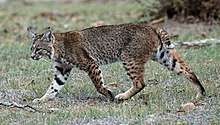Cats in the United States
Many different species of mammal can be classified as cats (felids) in the United States. These include domestic cat (both house cats and feral), of the species Felis catus; medium-sized wild cats from the genus Lynx; and big cats from the genera Puma and Panthera. Domestic cats vastly outnumber wild cats in the United States.

Prehistoric cats
At least 67 species of sabertoothed cats existed in North America between 42 million and 11 thousand years ago before going extinct. Their disappearance can be attributed to both the changing climate at the end of the Ice Age and the appearance of humans in the Americas.[1]
Some prehistoric animals referred to as "saber-toothed cats" were in fact marsupials and not cats at all, but called such because of their resemblance to true felines with large canine teeth and because “saber-toothed marsupials” didn’t sound nearly as cool.
Big cats
Two main species of big cat once inhabited the United States. One is the jaguar (Panthera onca), which is related to many species of big cat found on other continents. Although jaguars used to be found in the southwestern U.S., now, despite some unconfirmed sightings, the furthest north the jaguar is known to roam in North America is central Mexico, although it is found throughout most of South America, its territorial limit being lands further south than northern Argentina.
The other North American 'big cat' is the cougar (Puma concolor), which is also known as the puma, mountain lion, catamount, and many, many other names. Despite weighing 70 kg. (150 lbs) on average and being called a 'mountain lion,' the cougar is not a member of Panthera and is more closely related to the domesticated cat than it is to lions. Cougars can be found throughout South America, Mexico, the western half of the U.S., and southwestern Canada. They once also roamed eastern North America, but are now confined to Florida in the U.S.
Wild cats

Three mammal species in the United States are referred to as "wild cats": the ocelot, the Canadian lynx, and the bobcat. However, none of these animals belong to Felis, the genus of the wildcat proper and the domestic cat. The ocelot is in the genus Leopardus, small spotted cats that mostly inhabit Middle and South America, while the lynx and bobcat are both in the genus Lynx.
A smaller cat than any of the above, the Jaguarundi (Herpailurus yagouaroundi), although mostly found in Central and South America, also occurs near the lower Rio Grande Valley in the southern tip of Texas. Being a near relative of the American cougar, the Jaguarundi is more closely related to true wildcats then the other cats mentioned here.
Domestic cats
The domestic cat, Felis catus or F. silvestris catus, is a popular pet, with an estimated 93.5 million cats kept as pets; about one third of all households in the United States keeping at least one. Eighty-seven percent of owned cats are spayed or neutered[2]
The Centers for Disease Control and Prevention does not require a certificate of health for cats brought into the United States, but cats are subject to inspection at ports of entry and may be denied entry. Cats must be quarantined regardless of place of origin when brought into Hawaii and Guam.[3]
Organizations
Various organizations using the term Society for the Prevention of Cruelty to Animals (SPCA) and in United States all organizations using the name SPCA are independent; there is no umbrella organization. Some of the more notable organizations include:
- American Society for the Prevention of Cruelty to Animals
- New Jersey Society for the Prevention of Cruelty to Animals
- Society for the Prevention of Cruelty to Animals, Monterey County, California
- San Francisco SPCA
The National Cat Groomers Institute of America is an organization devoted to training and certifying people in the grooming of cats. Headquartered in Greenville, South Carolina, it was founded in 2007 by Danelle German, the organization's current president.
Cats Indoors! is a public education campaign by American Bird Conservancy and supported by the National Audubon Society and other conservation organizations to encourage control of cats in order to protect birds from predation by cats. The objective of the conservancy's campaign is that all domestic cats should be kept safely indoors.[4]
See also
References
- Ward, Peter (1997). The Call of Distant Mammoths: Why The Ice Age Disappeared. New York: Springer-Verlag New York. ISBN 0-387-94915-1.
- "U.S. Pet Ownership Statistics". The Humane Society of the United States. 30 December 2009. Retrieved 16 July 2011.
- "Bringing an Animal into U.S.: Cats - Animal Importation". Centers for Disease Control and Prevention. 29 January 2010. Retrieved 16 July 2011.
- Gorman, James (18 March 2003). "Bird Lovers Hope to Keep Cats on a Very Short Leash". New York Times. Retrieved 10 July 2008.
Further reading
- Loyd, Kerrie Anne T.; Sonia M. Hernandez (2012). "Public Perceptions of Domestic Cats and Preferences for Feral Cat Management in the Southeastern United States". Anthrozoös: A Multidisciplinary Journal of the Interactions of People and Animals. 25 (3): 337–351. doi:10.2752/175303712X13403555186299. ISSN 0892-7936.
External links
- Companion Animal Demographics in the United States: A Historical Perspective, Elizabeth A. Clancy et al., book chapter in D.J. Salem & A.N. Rowan (Eds.), The state of the animals II: 2003 (pp. 9–26), Humane Society Press.
- National Cat Groomers Institute of America
- Little Girl and Tomcat